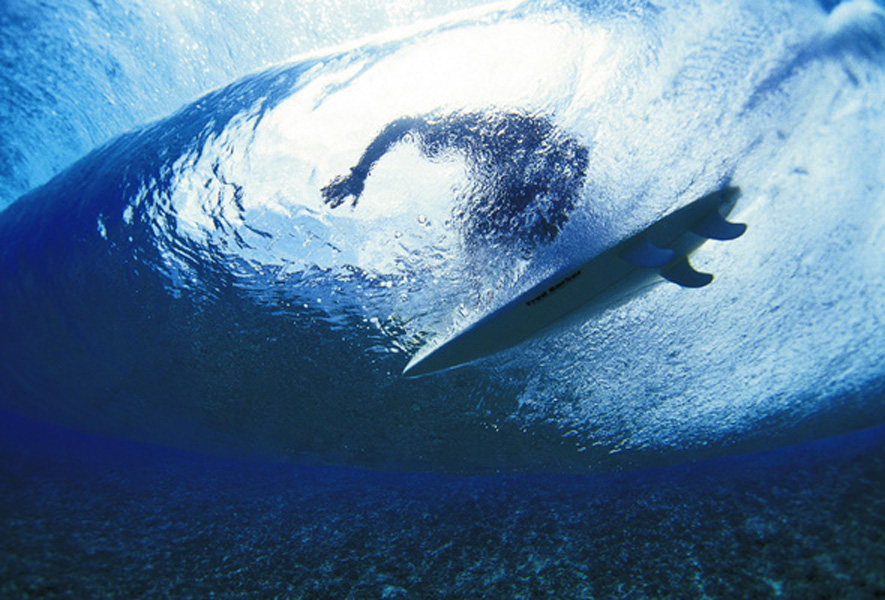SPEED, DRIVE & DIRECTION

THERE’S SOMETHING ABOUT FINS
The main purpose of a fin is to allow a surfer to turn a surfboard and press against the fins resistance whilst surfing to provide forward drive. The wrong fins on a surfboard can set your surfing back a long way – but there are those who’ll tell you that different fin designs and fin configurations are nothing more than a fad, selling gimmick or cosmetic accessory.
THE LOW DOWN
The wrong fins can cause you to lose drive, speed and / or hold in critical sections of large, steep, hollow waves – the right ones can get you through these and also flat (dead spots) in thick slow forming waves.

Let’s look at what a surfboard fin is and how it works:
There are options for the inner surface of the fin or what is commonly known as the inner foil where water is channelled from the bottom surface of the surfboard onto the inner surface or foil of the fin and then either directed in a laminar flow down the length of the fin to the tip and also directed towards the trailing edge of the fin. If there is a concave foil on the inner surface, that is an inner curve, the laminar flow of water will become compressed as it nears the trailing edge and then release as it passes the edge itself, theoretically releasing the water from it’s compressed state, and “squirting” it out the rear end of the surfboard. The outer foil acts much like an aerofoil on an aircraft, which has a leading edge that separates the prevailing flow of water into two channels, one outer and one inner. The trick here is to achieve this with as little drag as possible whilst maintaining a laminar flow of water without disturbances or turbulence.
In relation to a cambered or asymmetrical fin or aerofoil, the water that flows over the outer surface of the fin creates low static pressure or uplift as the water that flows over the inner surface creates high static pressure. The theory here is to generate lift therefore de-weighting the surfboard as it moves through the water, creating an environment conducive to generating speed.
The other effect this has, if enough lift is generated is to lift the rear end of the surfboard to a higher position in the water reducing drag providing more speed. It has not been quantified as to whether a surfer riding a surfboard in normal conditions can achieve this though the theory is there.
FCS (Fin control Systems) are a brand of removable fins, they designed the H2 fins which have an angular rake, and are cantered out providing a fin (or hydrofoil) which provides lift at the rear end of a surfboard effectively providing buoyancy and speed at the rear end and a better trim angle. Also added to this, it will lift some of the fin out of the water, loosening up the rear end of the surfboard and provide extra hold on steep take-offs from having the fin more vertical as it passes through a leaned bottom turn on the inner rail. The only draw back of these fins is that they tend to lose drive out of sharper “jammed” bottom turns.
As a rule of thumb.
- The longer the base of a fin is, the more drive it will provide.
- The more rake and narrowness at the top of the fin, the more speed and looseness you will experience through and out of turns.
- The stiffer the fin material, the more drive you will achieve translating to more speed, though will be a little tighter through turns and arcs.
The whole anomaly regarding fins is this – a fin design has many considerations which are as follows.
- The fin needs to work with the particular surfboard shape that it is attached to which takes into account the positioning the fin in relation to the surf board and prevailing water flow.
- What the surfer wishes to achieve from the fin taking into account his or her weight, strength, the wave size and shape the surfer will be riding. This also translates in to whether the surfer desires, speed, lift, drive, release and hold.
- Surfboards turn and twist in many different directions erratically and require speed into and out of these turns.
- The prevailing water flow is not always laminar and is sometimes turbulent and froth (Full of bubbles and bumps. (It’s not a controlled science.
- The method of attachment of the fin to the surfboard.
- Placement of the fins.
- Fin construction including foils, rake, base, flex, camber, materials.
So you can see there is no simple answer.
There are now many players in the fin market including Futures, FCS, Shapers, Power Base to name a few. There is also a new breed of experimental fin manufacturers who are designing, fabricating, testing and marketing new fin concepts such as 3D fin designs that are providing some interesting and encouraging results.
Feel free to sound off in the comments.
via: FCS Fusion amazingdata


Comments are closed.